WHEEL OF KINETIC ENERGY – A Kinetic Roulette
This is a modal window.
THE CHALLENGE: Power up a light using kinetic energy
THE CHALLENGERS: Marcelo Cespedes, Angela Perrone & Jamie Ruddy
SETTING UP
Finding a means to power up an LED using a motor and kinetic energy may sound like a straight forward task, but it took many ideas, iterations and implementations to get the final product up to the challenge.
We began by setting up the basic circuit fit for a stepper motor. This included two rectifiers and two capacitors. With some torque and a bit of elbow grease, we were able to light up a 2V LED.
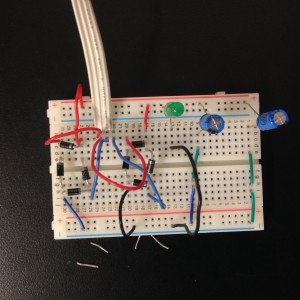

DESIGN #1
Inspired by Jamie’s solution the obesity and energy crises, we decided that generating energy from a stationary pedal system would be a step in the right direction.
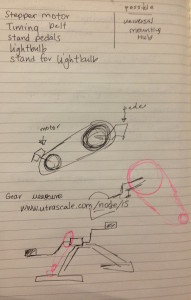

However, without having this device to take apart and see if our idea was possible, we were unable to move forward with this idea. So we moved on to a new option.
DESIGN #2
We decided to embark on a pulley system. The first thought was to have the ends of the ropes attached to boxing gloves, where the punches would move the motor. Since the natural movement of punches would not facilitate the current needed for lighting the LED. But we did realize that the natural movement of a strip tease by way of a boa, would be perfect. Enter:
Roxanne, The ElecStrip Tease
“Sell Your Body to the Light”
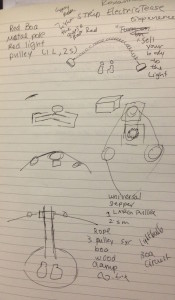
We set out to Home Depot, a candy land of pulleys, ropes and bolts. It was here that we mapped out the fabrication of the project with the help of the HD staff who knew their way around nuts and bolts.
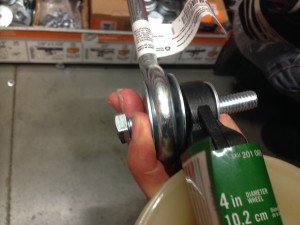
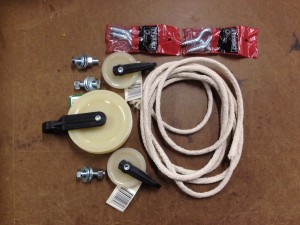
We set up our pulley system in several ways, testing out which option would provide the most voltage, with the promise of powering a stronger-than-an-LED bulb for the final iteration. Various configurations and tests later, we were not getting enough voltage for more than a quick burst of light in a small LED. No matter how much pull we gave, we were getting on average 6 volts, and up to 11 at less intervals.
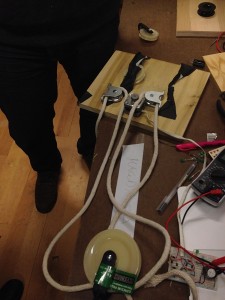
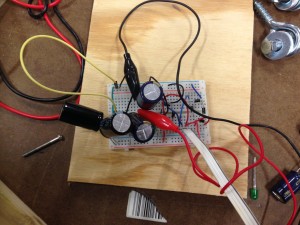
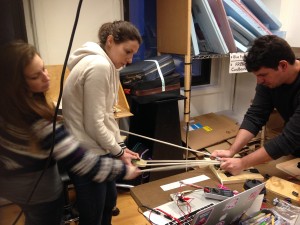
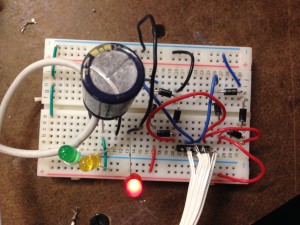
DESIGN #3:
Sometimes you have to improvise with what the junk shelf gives you. And improvise, we did.
The Materials:
large fan-like shell
two gears
super glue
hot glue
acrylic from a record player cover
5V to 12V boost module
wood scraps
acetone (to remove item from hand after super glued together)
stepper motor
3 capacitors (4700µF, 10V)
12 V light & adapter
Marcelo designed the gears in illustrator and cut them out with the laser cutter. We mounted a small gear onto the top of the stepper motor. and affixed the larger gear to the top of the fan structure.
While the fabrication was underway, we revisited the circuit. How were we going to generate enough power to light a 12V when our readings were topping off at 5/6V? After discovering the magic of the boost module, we quickly acquired one and experimented with it in the bread board. A WIN!
In order to power up the light for a little extra time and to engage the capacitor, we added a button, so that when the motor is spun, the joules could build up, giving an extra boost upon opening the flow of the current with the button.
And with this final touch, we have ourselves a competition!
*Note: We realized that the boost module was not adding anything to our circuit, so we have since removed it.
This is a modal window.




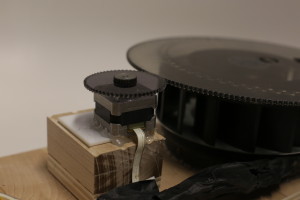

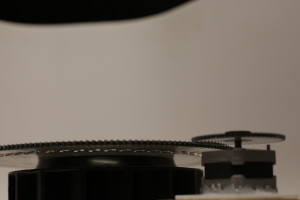
SCHEMATIC

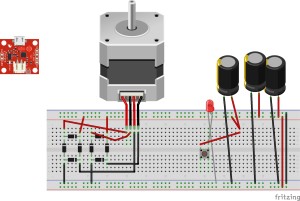



BOM
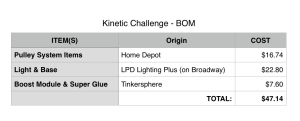
CALCULATIONS


Leave a Reply